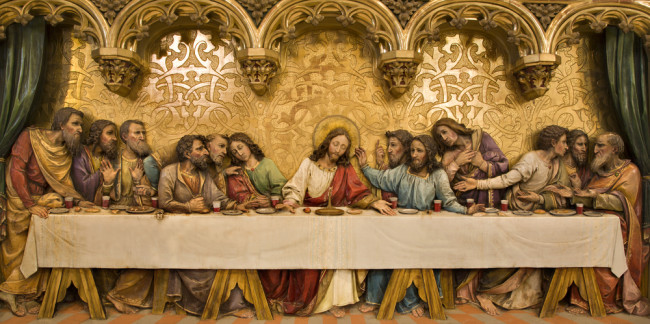Worship Materials: Maundy Thursday
From the Festive Worship collection

THEME Feast of Death – Feast of Life
THOUGHTS FOR REFLECTION
- The mystery of the Eucharist (Holy Communion, Mass) is only fully perceived when all flesh is seen as embodying both the suffering and the delight of God.
- Behind the word, the symbol-
Behind the symbol, the mystery
And within them all the presence of God. - The Eucharist not only stands in the tradition of the last pre- crucifixion supper, but it also embodies the experience of the first post-resurrection breakfast (John 21/1-14) and the first post-resurrection supper (Luke 24/13-35).
- The Eucharist provides a prism for viewing both the painful and the joyful realities of life. Within it we can reconnect both with our tears of anguish and our songs of joy.
- History birthed the Eucharist – the events of today give it its power.
- In the sharing of bread God is both the giver and the receiver.
- Access to the inner mystery of the Eucharist is through holy playfulness, consecrated sensuousness and liberated use of words and actions.
- When we cling to outmoded images and archaic language our liturgies are in danger of becoming memorials to a dying God.
- When you seek to find God only in the liturgy, be aware that the spirit may intrude in the guise of a wandering alcoholic.
- Eucharists that foster dependency do not stand in the tradition of Christ the liberator.
- Not the immaculate uniform of servility, but the crumpled garments of sacrifice.
- If the Eucharist is to lose its appearance of cannibalism, we need to make more explicit the fact that in Hebrew the word blood equals life and the word body means total personality. So in effect we are participating in the life of Christ.
- In the abandoning of pride lies the greatest chest of riches.
PRAYER
O Jesus Christ, who invited us to allow bread and wine to feed both our bodies and our spirits, may all that we see, all that we touch, all that we taste lead us into communion with the God who is both beyond and within, the God whose embodiment we share.
HYMNS
Can bread and wine? Sacred Presence (BL)
Can bread and wine? Clonmel (BL)
To you, O God, we offer. (BL)
To God the process. (BL)
O golden cup of life.(BL)
O golden doors now open wide.(BL)
Taste and see.(BL)
The patterned mystery.
www.methodist.org.nz/whakapono/online-resources/hymns/with-heart-and-voice
I am more than flesh and bone says Christ.
http://www.methodist.org.nz/whakapono/online-resources/hymns/the-mystery-telling
With God we shape compassion’s robe.
http://www.methodist.org.nz/whakapono/online-resources/hymns/the-mystery-telling
Christ the tent.
http://www.methodist.org.nz/whakapono/online-resources/hymns/the-mystery-telling
“I wash my hands”.
http://www.methodist.org.nz/whakapono/online-resources/hymns/the-mystery-telling
The way of the Christ. (STS1)
We will celebrate with praises. (STS1)
Behind the bread. (STS2)
Help me to pray as Jesus prayed. (STS2)
All our hearts and minds. (STS2)
Singing the Sacred, Vol 1 2011, Vol 2 2014 World Library Publications
POEMS / REFLECTIONS
BEHIND AND WITHIN
Eucharist is the feast of seeing behind and within;
behind the bread to the sales-assistant,
baker, miller, farmer; to the plant, the seed,
the earth, to the sun and moon, air and water;
to the cosmic explosion that birthed the universe,
to the God who is in all
and through all;
And also the knowledge that our eating starts another process
that leads back to the earth and
the perpetual recycling of the atoms,
temporarily part and parcel of this bread,
this particular part of the body of Christ.
Indeed the divine that is in this bread is sign and symbol
of the sacred process of recycling.
BROKEN BREAD
No one coming to receive communion
seemed more Christ-like
than the woman
with flailing arms,
misshapen legs
and wobbling head.
Like Isaiah’s Messiah
she had no comeliness
but through her brokenness
God’s love ministered
to this misshapen world.
FOCUS FOR ACTION
- What type of service should we offer if we followed the example of Christ’s foot washing? Christ did not surrender his power to others, whether they were individuals, groups or institutions. “No one takes my life away, I give it up of my own free will”, said Jesus. (John 10:18) We are called to move from dependency to self-affirmation (owning our own power), to divine affirmation (interdependency), where we share the power of the universe in a compassionate manner. Jesus also said, “You will do even greater things than I have done”. (John 14:12) When we open our life to God, it is not to a despot but to a co-worker. (2 Corinthians 6:1)
- Does the form of Eucharist I participate in only reflect the Last Supper or does it have the feel about it of a Resurrection celebration? Does it hold together joy and sorrow? Does it prepare me for both dying and for living? How can I help to bring about changes in the Eucharist to help make it a feast of life, a festival of the process of recycling and of connection?
Text and image © William Livingstone Wallace but available for free use.

